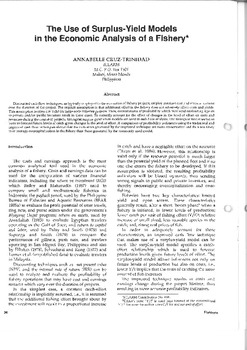The use of surplus-yield models in the economic analysis of a fishery

Citation
Trinidad, A.C. (1990). The use of surplus-yield models in the economic analysis of a fishery. Fishbyte 8 (2): 20-24
Discounted cash flow techniques, as typically employed in the evaluation of fishery projects, employ constant cost and revenue streams over the duration of the project. The implicit assumption is that additional effort in the fishery does not adversely affect costs and yields. This assumption is often not valid for large scale fisheries projects. Thus, overestimates of profitability which may send misleading signals to private and / or public investors result in these cases. To correctly account for the effect of changes in the level of effort on costs and revenues during the course of projects, biological surplus production models are used in cash flow analysis. The biological model serves as basis to forecase future levels of catch given changes in the level of effort. A comparison of profitability indicators using the traditional and improved cash flow techniques shows that the indicators generated by the improved technique are more conservative and thus less likely to encourage overcapitalization in the fishery than those generated by the commonly used model.
Permalink
Date Available
Type
Publisher
Copyright
CC BY 4.0
Research Themes
Topics
Language